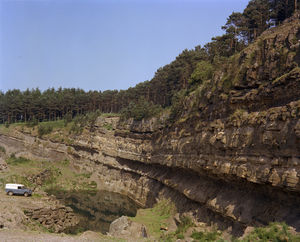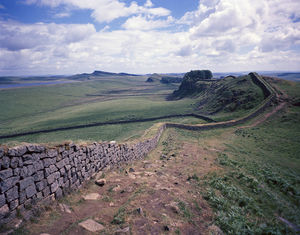Northern England district - North Cumbria and Northumberland


The area of North Cumbria and Northumberland adjacent to the Scottish border is predominantly rural with no major towns.
Sedimentary bedrock
The fells of the Bewcastle and Liddesdale areas are underlain by a series of alternating layers of sandstone, limestone and mudstone of similar age to the Carboniferous Limestone, sandstones and Coal Measure already described from the Lake District (Plate P222366). These were laid down in shallow seas and by rivers commencing around 360 million years ago. These layers dip south toward the Tyne Valley, where they form a sequence that is more than 4 km thick.
Inland from the Northumberland coast a series of ridges are formed by hard, resistant rocks. Most of these ridges are beds of tough sandstone or limestone within softer mudstone layers. However, the most prominent of these ridges is made by a sheet of much harder, dark rock known as dolerite, forming the Whin Sill. This rock was injected as a sheet of molten rock or magma between the sedimentary layers, rising from great depth about 300 million years ago. This sheet, which has an average thickness of about 50 m in this area, is exposed from north Northumberland westwards to the Tyne valley and it provides the imposing foundation for Hadrian’s Wall for much of its length (Plate P222329). Boreholes show that the Whin Sill continues south-eastwards at depth where it is encountered for example at 460 m depth at Longhorsley. At Whitley Bay it has split into two layers which occur at depths of about 800 and 1050 m.
Water supply across this area comes mainly from surface reservoirs. Of these, Kielder Water in the uppermost reaches of the River North Tyne, is the largest and supplies Tyneside, Wearside and Teesside by transfer of water from the Tyne into the Wear and Tees. In addition, many of the thicker sandstones in the area have been developed as aquifers giving good yields above depths of about 250 m with the flow occurring along fractures.
Basement rocks
Basement rocks, comprising hard mudstone, lavas and an intrusion of granite about 395 million years old form the Cheviot Hills in the north-east of this area. This granite is of comparable age to the younger granites present in the Lake District, e.g. at Shap. The basement is present at depth farther south beneath the sedimentary bedrock, but the depth to this basement as indicated by seismic surveys reaches 4-5 km in the Tyne valley and here the character of the basement rocks has not been investigated with boreholes.